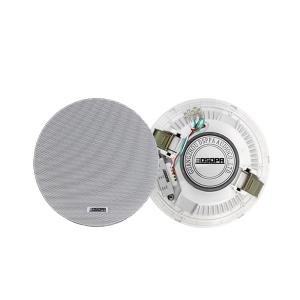

Chat now



The layout of surface mount ceiling speakers is actually diverse, including center-to-center layout, minimum overlap, and edge-to-edge layout.
Among them, the minimum overlap layout method should be the best method, which not only satisfies the uniform coverage of each area but also avoids acoustic interference to the greatest extent.
According to the ceiling height of the room and the speaker radiation angle, the radiation radius of a single surface mount ceiling speaker can be simulated and calculated, so as to know how many speakers are properly arranged in the room (calculated according to the sound attenuation principle of point sound sources); The sound pressure level of the surface mount ceiling speakers in the conference room is relatively small, and everyone will have a question. How can a ceiling with such a low sound pressure satisfy the sound reinforcement of a conference room with tens or even hundreds of square meters? This is related to a problem in the calculation of sound pressure level attenuation. The calculation follows the principle of point sound source sound attenuation:
If the sensitivity of a ceiling speaker is 89dB, the rated power is 50W, and the ceiling height of the conference room is 3 meters, then the maximum sound pressure level reaching the human ear can reach:
89dB+10log(50W)-20log(3m-1.2m)=101dB
[Note: 1.2m is the height of human ears]
The European law on hearing protection states that people cannot work for more than 8 hours a day at a sound pressure of 90dB, and no more than 4 hours at a sound pressure of 95dB. By analogy, each increase of 5dB will reduce the time by half, and can only work for 2 hours under the sound pressure of 100dB. And 90dB is the ideal sound pressure for a meeting, ensuring that everyone can hear a clear sound, and at the same time there is a sufficiently large sound pressure level. Therefore, the surface mount ceiling speaker only needs to output a few watts of power to meet the sound reinforcement needs of the conference room, which not only improves the sensitivity of the microphone but also effectively suppresses howling.
 【DSPPA Demo】PAVA8000 EN54 Voice Evacuation SystemNovember 12, 2020Abstract: DSPPA PAVA8000 EN54 Voice Evacuation SystemToday, we are gonna show you a demo about our PAVA8000 EN54 Voice Evacuation System.PAVA8000EN54 Voice Evacuation System can not only support manua...view
【DSPPA Demo】PAVA8000 EN54 Voice Evacuation SystemNovember 12, 2020Abstract: DSPPA PAVA8000 EN54 Voice Evacuation SystemToday, we are gonna show you a demo about our PAVA8000 EN54 Voice Evacuation System.PAVA8000EN54 Voice Evacuation System can not only support manua...view The National Standard Approval Meeting held in BeijingJuly 19, 2019The National Standard Approval Meeting held in BeijingThe approval meeting of the National StandardTechnical standard of public address system engineeringis held in Beijing on July 16, 2019. Xue Chang...view
The National Standard Approval Meeting held in BeijingJuly 19, 2019The National Standard Approval Meeting held in BeijingThe approval meeting of the National StandardTechnical standard of public address system engineeringis held in Beijing on July 16, 2019. Xue Chang...view


